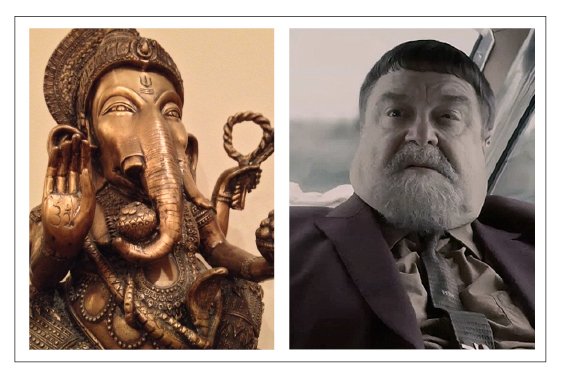Good news. I'm not crazy ... at least, not totally crazy. John Goodman cleared that up for me.
Last Thursday night I attended a screening of the new film by Joel and Ethan Coen, Inside Llewyn Davis, followed by a Q&A session with Goodman, America's favorite man-mountain character actor, who is one of its stars. The film is a dark comic odyssey (hey, it's the Coen brothers) about a struggling folksinger in the circa-1963 Greenwich Village scene, loosely based on the late Dave Van Ronk. The hero sleeps on couches, bums sex and cigarettes, and watches the gods of success pass him by as they pluck out the few Bob Dylans and Peter, Paul and Marys who are marked for fame. Goodman plays a twisted, addicted, narcissistic old jazz musician in a bad hairpiece, nodding out in the backseat of a car on an endless New York-to-Chicago road trip, who occasionally rouses himself only to prattle on with long, self-involved tales or to taunt and torment Llewyn. In the hands of the Coens and Goodman, his rants become grotesque, hypnotic poetry, probably the best thing in the film.
In the Q&A, I asked Goodman about something I had experienced in 2009, when I saw him on Broadway as Pozzo in Waiting for Godot -- and couldn't take my eyes off him. In some mysterious way, his presence on the stage was so riveting that it filled the entire space of the theater. Pozzo spends half of act 2 lying on the ground in an extended I've-fallen-and-I-can't-get-up moment (which made Goodman look like a beached whale, struggling to make his way back to the water), but even then he radiated a vibrational mojo so powerful that he seemed to be the hub of the universe, with everything else in fuzzy orbit around him. This, I thought, must be the kind of power that held crowds in fascinated thrall to Jesus or Buddha ... or Hitler, for that matter.
It was such an altered-state, reality-warp phenomenon that, as I asked Goodman about it, I added , "And I wasn't high."
"I was," he joked back.
"But," I asked, "was it just me, or do you have any idea what I'm talking about? And if so, how do you do that?"
His response was a gracious "Thank you." Then he explained that what he tries to do on stage goes back to his theater training in college, which included inner, mental exercises with one primary task: "Fill space."
Aha. There it was.
"And not by bringing attention to yourself," he went on. "Not by gesturing, but by allowing silence. And listening -- that's really important."
So I wasn't crazy. (At least not on that count.) Although I've encountered this sort of thing with some of the more realized yogis, lamas, and gyanis I've hung around with for the past 40-odd years, I had never experienced it so palpably with a performer. But Goodman's explanation made it make sense. On the higher levels, learning to act -- to fully, vividly be, settled and at home in the skin of another person -- is a lot like the meditative practices that help us to fully, vividly be, settled and at home in our own skin. In both cases, it doesn't happen through anything you do or say on the outside ... through drama. It happens inside, in simple, self-sufficient silence. Then whatever you do or say flows from that silence as an expression of its deep power. It fills the space.
We see this silence in all the best actors. Al Pacino is an especially interesting case: The silence and the listening are there in his early work, such as Godfather I, a job he almost lost when the studio heads, watching the rushes of the opening scenes, complained to Francis Coppola that Pacino wasn't doing anything. In his later films he succumbs to look-at-me preening, strutting and fretting his hour upon the stage -- the way I did as a kid, practicing melodramatic death scenes in front of my parents' full-length bedroom mirror.
"The way to do is to be," says the Tao Teh Ching. That's true whether your stage is the world or your stage is the stage. Being itself -- pure, silent existence, which is before and after and during every moment of our noisy lives -- is not just an absence, void, or black hole. It has no color or shape, no texture or tone, but it's the bottomless richness out of which all life's colors and shapes and textures and tones proceed. And it's possible not only to encounter that rich silence, but to steep in it, marinate in it, till you're so soaked in it that everything you do is sopping. Depending on where and how you marinate, you might call it meditating, or acting, or -- oh, I don't know -- dancing, driving, golfing, crocheting ...
Then you can do anything, out to the farthest edges, and never lose the center. (This is precisely the opposite of the cliché of the meditator as jellyfish, tepid and passive.) Perhaps no one embodies all this better than Goodman. He's been blessed with amazingly versatile equipment, including a vocal range that stretches from sensitive, vulnerable tenor to rumbling, menacing bass, and he uses it all with yabba-dabba-doo gusto. He specializes in extravagant characters that are 'way larger than larger-than-life, almost as if in illustration of the wisdom texts which teach that the farther you draw the arrow back into silent being, the farther it can fly forward into active doing.
In the Hindu pantheon, this teaching is personified by Lord Ganesh, the jovial, big-bellied, elephant-headed god. As with all the gods, the point of Ganesh is that he is us -- us when we have stepped into our full glory, no longer crammed into the rickety little poor-me/great-me life stories we've been driving around in all this time. Ganesh's big ears are for ever-receptive listening. His trunk is strong enough to uproot a tree, yet sensitive enough to shell a peanut: that's how to do stuff. No pale ascetic, he chows down on platefuls of sweet desserts. And with all his great mass, he loves to dance. In short, he's a lot like John Goodman.
One more thing:
At the center of all the whirling changes of life, in the eye of the storm, Lord Ganesh holds up one hand, palm outward, in the gesture known as abhayamudra, signifying "Fear not -- all is well." In Thursday night's Q&A, one questioner inevitably brought up Goodman's most beloved character, Walter Sobchak, the deranged Vietnam vet of The Big Lebowski. He asked Goodman what was his favorite of Walter's many oft-quoted lines. His response: "Nothing is fucked here, Dude." On the face of it, that's completely and hilariously deluded. Everything Walter touches goes wrong, right up to his maudlin funeral oration for his friend Donny, climaxed by Donny's ashes blowing into his face. In Walter's world, pretty much everything is fucked.
Yet that line is also a precise translation of Lord Ganesh's gesture. When you're settled into the deep silence at your core, no matter how messed up things get at the surface, there's an all-pervading OK-ness that percolates up through all of it. I think we love Walter because, even as he blunders his way from one needless disaster to another -- just like us -- he also radiates, in spite of it all, an inextinguishable innocence. He may be a raving, gun-waving lunatic, but he's also a big, sweet baby. He's OK.
Fear not. I'm OK, you're OK. Despite appearances, things are somehow amazingly, silently OK.
Breathe out. Nothing is fucked here, Dude.

